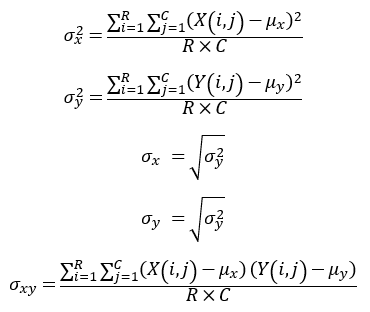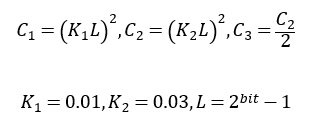python numpy版本SSIM复现与算法解释
目录
-
- 1. 简介
- 2. 算法
-
- 2.1 公式一
- 2.2 公式二
- 2.3 公式一的子项计算
- 2.4 常量
- 3. 复现代码
-
- 3.1 基于公式一的实现
- 3.2 基于公式二的实现(高斯滤波)
- 3.3 skimage的structural_similarity函数
- 4. SSIM-Loss
- 5. 测试
1. 简介
SSIM是一种图像评估指标算法,在算法实现里面输入是两张图片,输出是两张图片的相似评估数值,输入两张一模一样的图片则输出是1。
2. 算法
x与y分别代表两张图片(两个矩阵)
SSIM可通过两条公式计算:
2.1 公式一
2.2 公式二
2.3 公式一的子项计算

下面为图像均值的计算公式:
R(rows)代表图片的行,C(columns)代表图片的列,X为图像第i行第j列的像素值。

下面为单张图像的方差、标准差和两张图片的协方差计算公式:

2.4 常量
3. 复现代码
3.1 基于公式一的实现
以下代码基于paddle的GAN代码里面的SSIM算法进行修改,这个版本是基于公式二。
import numpy as np
# 该函数作用于单通道
def ssim_1(img1, img2, L):
"""Calculate SSIM (structural similarity) for one channel images.
Args:
img1 (ndarray): Images with range [0, 255].
img2 (ndarray): Images with range [0, 255].
Returns:
float: ssim result.
"""
K1 = 0.01
K2 = 0.03
C1 = (K1 * L)**2
C2 = (K2 * L)**2
C3 = C2/2
img1 = img1.astype(np.float64)
img2 = img2.astype(np.float64)
# ux
ux = img1.mean()
# uy
uy = img2.mean()
# ux^2
ux_sq = ux**2
# uy^2
uy_sq = uy**2
# ux*uy
uxuy = ux * uy
# ox、oy方差计算
ox_sq = img1.var()
oy_sq = img2.var()
ox = np.sqrt(ox_sq)
oy = np.sqrt(oy_sq)
oxoy = ox * oy
oxy = np.mean((img1 - ux) * (img2 - uy))
# 公式一计算
L = (2 * uxuy + C1) / (ux_sq + uy_sq + C1)
C = (2 * ox * oy + C2) / (ox_sq + oy_sq + C2)
S = (oxy + C3) / (oxoy + C3)
ssim = L * C * S
# 验证结果输出
# print('ssim:', ssim, ",L:", L, ",C:", C, ",S:", S)
return ssim
3.2 基于公式二的实现(高斯滤波)
代码来自paddle使用高斯核卷积
def ssim_2(img1, img2):
"""Calculate SSIM (structural similarity) for one channel images.
It is called by func:`calculate_ssim`.
Args:
img1 (ndarray): Images with range [0, 255] with order 'HWC'.
img2 (ndarray): Images with range [0, 255] with order 'HWC'.
Returns:
float: ssim result.
"""
C1 = (0.01 * 255)**2
C2 = (0.03 * 255)**2
img1 = img1.astype(np.float64)
img2 = img2.astype(np.float64)
kernel = cv2.getGaussianKernel(11, 1.5)
window = np.outer(kernel, kernel.transpose())
mu1 = cv2.filter2D(img1, -1, window)[5:-5, 5:-5]
mu2 = cv2.filter2D(img2, -1, window)[5:-5, 5:-5]
mu1_sq = mu1**2
mu2_sq = mu2**2
mu1_mu2 = mu1 * mu2
sigma1_sq = cv2.filter2D(img1**2, -1, window)[5:-5, 5:-5] - mu1_sq
sigma2_sq = cv2.filter2D(img2**2, -1, window)[5:-5, 5:-5] - mu2_sq
sigma12 = cv2.filter2D(img1 * img2, -1, window)[5:-5, 5:-5] - mu1_mu2
# 公式二计算
ssim_map = ((2 * mu1_mu2 + C1) *
(2 * sigma12 + C2)) / ((mu1_sq + mu2_sq + C1) *
(sigma1_sq + sigma2_sq + C2))
return ssim_map.mean()
3.3 skimage的structural_similarity函数
skimage从1.17版本开始将compare_ssim更名为structural_similarity。
from skimage.metrics import structural_similarity
4. SSIM-Loss
该函数可作为部分神经网络的loss function,如图像生成网络等,计算output与label的相似度,SSIM-Loss如下:
S S I M L o s s = 1 − S S I M ( o u t p u t , l a b e l ) SSIM_{Loss}=1-SSIM(output, label) SSIMLoss=1−SSIM(output,label)
5. 测试
测试图使用肺部胸片与去肋骨后的胸片进行测试。
原图:
去肋骨后:
代码与输出:
if __name__=="__main__":
origin_path = './origin.png'
pred_path = './pred.png'
img_ori = image.open(origin_path)
img_pred = image.open(pred_path)
X = np.array(img_pred)
Y = np.array(img_ori)
# 两者最后都需要做一个abs!!!!!!!!
# 非高斯滤波
print(abs(ssim_1(X, Y, 255))) # output:0.0002043533434396722
# 高斯滤波
print(abs(ssim_2(X, Y))) # output: 1.8464489378357714e-05


